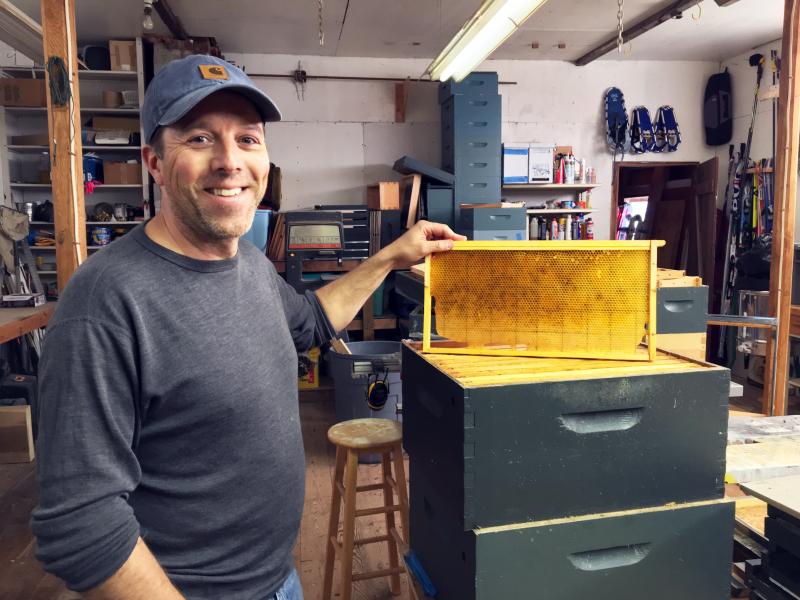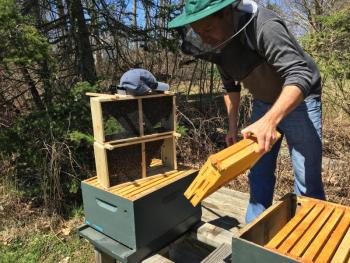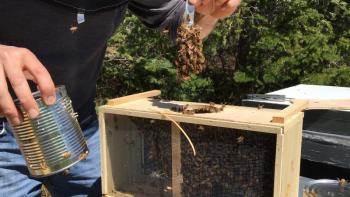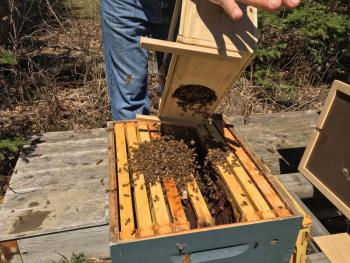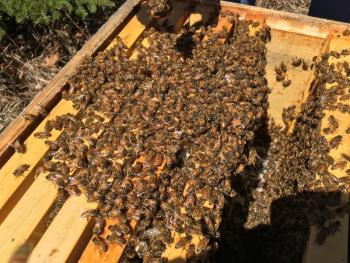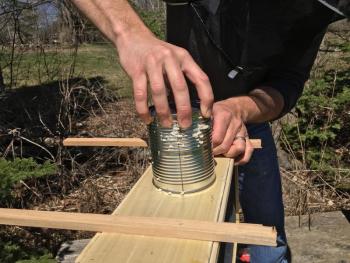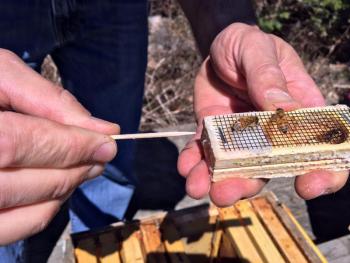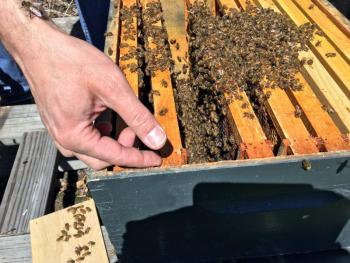Biologist Tim Forrester, a wetland scientist, is an environmental consultant.
Forrester lives with his wife, Bethany, and their children, Ben and Lily, in Woolwich. In the expansive backyard, there are some chickens and an obnoxious rooster who does his best to make the hens’ lives miserable.
In Forrester’s spare time, he’s a beekeeper. And bees make honey.
A board member of the Maine State Beekeepers Association, Forrester decided he wanted to try his hand at beekeeping eight years ago when he and a friend attended a few classes. His first one was with a woman named Erin Forbes, one of the first female master beekeepers in Maine. “She single-handedly is revolutionizing beekeeping in Maine,” he said. “She's an ambitious, exciting woman. She helped me get motivated in beekeeping.” Forrester said another mentor is Phil Gaven of the Honey Exchange in Portland.
There are three types of bees in a colony: Drones, workers and the queen. A drone is a male whose only job is to mate with a virgin queen. Drones have no stingers, and after they’ve done their duty, it’s all over for them. “The queen will mate with a bunch of drones, and for the drone it’s one, and done,” Forrester said. “Once he mates with a queen his accessories are torn from his body, and he dies.”
The workers are females, and they spend their lives doing just what their name implies: Working. Though they’re females, they are born with underdeveloped ovaries, and therefore don’t reproduce. But without them there would be no colonies, or bees. They wait on the queen, forage for pollen, pollinate blossoms, build wax cells and produce the honey they deposit into the cells.
The workers are also the bouncers of the colony. In the fall, they kick the drones out, as they are no longer needed that year. The workers guard the hive from intruders.
Then there’s the queen. She’s the leader, and the mother of all the bees in her colony. The queen is larger than her subjects, with a longer abdomen. She’s the only fertile bee in the colony – the only one who reproduces. As a new “virgin” queen, she’ll go on ‘mating flights,’ mate with a handful of drones, then return to the colony, crawl inside, and that’s where she’ll stay and often not come back out again unless she swarms. The bees’ form of reproduction is to swarm.
On April 23, Forrester was busy transferring bees from a new three-pound package — a box from Georgia — into his Langstroth hives. Forrester assembles the wood frames that are inserted into the hives, with foundations the bees will “draw out” and build their wax combs on.
The box from Georgia comes with a tin can filled with sugar water inserted into one end. In a wooden queen cage is the queen bee. A cork seals her in. Forrester digs a small hole through the cork, to give her bees a head start in freeing their queen from her cage, and carefully places the cage in the hive. Then he “thumps and dumps” the hundreds of workers into the hive by tapping the box on the ground and shaking them out. Of course, the bees aren’t all cooperative, and a swarm forms around the hive.
The good news is they have no desire to be anywhere but close to their queen. “It's all about the queen,” Forrester said. “She communicates through pheromones. She gives off that pheromone, and the bees sniff her out and find her. So they always know where she is, and all is well.”
If there's a threat, the bees emit an “alarm pheromone.” It smells like bananas. Forrester said you'll know, by the banana smell, when you approach a hive and you've done something wrong. “It will smell like bananas. Take a step back and figure what's going on before you go any further. If they sting you, the pheromone will stay with you, and that's why bees will continue stinging you.”
The hives are built from the bottom up, with one deep box and at least two medium-sized boxes he piles on top of one another. Hives sometimes end up with five medium boxes that will eventually contain 30 pounds of honey per box.
There might be 60,000 to 70,000 bees in a colony, and Forrester said he might get a hundred pounds of honey from a single good, strong colony.
Once the bees have done their jobs and produced the honey, it is extracted by removing the honey-laden frames from the hives, scraping the thin layer of wax from each side with a heated electric knife, and placing the frames in a centrifuge, which whips the honey out. It is then run through filters to remove small pieces of wax.
The Forresters have 30 fruit trees in their yard – apple, pear and peach. “So when the blossoms open up, and the whole lawn turns to clover and dandelions, I don’t have to do anything. My bee food is all right here.”
Forrester said a beekeeper can spend as much or as little time as he chooses tending the bees. “Right now, because the package of bees has just arrived, I have to install them and keep an eye on them until they build up a little. But tending them is not time-critical. You can play your schedule, you can play the weather, and there’s a little bit more leeway.”
And once the honey has been extracted from the hives and stored in jars, Forrester can relax and simply enjoy the fruits of their labor for a long time. “Honey never goes bad, It will crystallize , but it won't go bad.”
Ben & Lily’s Pure Local Honey can be found at 135 River Road in Woolwich after July 4. There will be a honey cart set upon the front lawn, and all the proceeds will go toward Ben’s and Lily’s college tuition. Forrester also supplies his honey to some local shops, and packages it for party favors and weddings.


